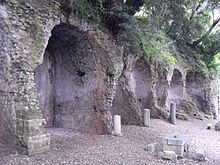Villa Gregoriana
The Villa Gregoriana is an extensive park in Tivoli near Rome, which combines ancient Roman elements with a romantic garden. The waterfall of the river Aniene plunges 120 meters into the villa. The park has been managed by the Italian Foundation for the Protection of Monuments and the Environment since 2002 and can be visited.
history
Ancient Tibur , now Tivoli, represented an important strategic position as a transit station for all those who followed the course of the Aniene from the east in order to reach the Tiber plain and Rome . The entire Aniene Valley could be monitored from the Acropolis of Tivoli. Shortly before the waterfall, a first (chargeable) bridge was built over the Aniene. The position of Tibur made it possible, despite the difficult geographic and hydrological situation, to build the first water technology systems in the 2nd century BC. This included twelve structures such as ditches, canals, locks and aqueducts as well as bridges and watermills, all of which were intended to either contain or use the Aniene. Some of them were still in use in the 19th century. At the time of the Roman Republic , several villas were built in the Anienetal, such as For example, the villa of Manlius Vopiscus, which was destroyed by a great flood of the Aniene in 106 and the ruins of which are in the Villa Gregoriana.
The work of Gregory XVI.
The park of the Villa Gregoriana was initiated by Pope Gregory XVI. back, who in the 19th century saw the need to protect Tivoli from the destructive floods of the Aniene, and at the same time tried to combine the useful with the aesthetic. The fountains of the Villa d'Este from the second half of the 16th century already used the water of the Aniene thanks to a canal that ran below the city walls. However, this canal was neither intended nor suitable to serve as an overflow for a possible flood. The construction of the Villa Gregoriana was supposed to counteract this deficiency. Pope Gregory XVI had further new canals and overflows built under the Monte Catillo after the severe flood disaster of 1826, which should keep the Aniene away from the city of Tivoli. In the conventional river bed, the water that could not drain through the new diversions collected and it was still used for civil and industrial purposes. Pope Gregory XVI equipped this part of the river with the Ponte Gregoriana. The ruins of the former villa of Manlius Vopiscus were uncovered and the individual elements were integrated into the garden area, which was equipped with steps, paths, passageways as well as new types of plants and essences. The work was completed in 1835 and the villa was inaugurated.
The hydropower plant
In 1886, the Aniene was caught below the waterfall in an artificial basin to produce electrical energy. Limestone concretions and caves in the rock suggest the earlier course of the Aniene.
description
Valle dell'Inferno (Devil's Valley)
The Villa Gregoriana is located in a steep ravine called Valle dell'Inferno (Devil's Valley), which Aniene cut into the porous tufa below the ancient Acropolis of Tivoli . The river plunges 120 meters down here. Of the original four falls, two are left today.
The acropolis
The acropolis above the Valle dell'Inferno houses two temples, a round temple that dates back to the 2nd century BC. And a pseudoperipteros from the 1st half of the 1st century BC. The assignment of the temples is controversial; Vesta , Albunea and Tiburnus were proposed. The park with the Roman temples, the waterfalls, the remains of Roman villas and the horticultural work can be found in numerous landscape paintings that have Tivoli as their theme. At the end of the 18th century, Tivoli became one of the stops on the romantic Grand Tour due to this peculiarity .
Todays use
The park, which is owned by the Italian state, was handed over to the FAI - Fondo per l'Ambiente Italiano in trust in 2002 . The FAI restored the then badly dilapidated facility and opened it to the public in 2005. The park is accessible from the center of Tivoli and can be visited all year round for an entrance fee.
literature
- Carlo Fea: Considerazioni storiche, fisische, geologiche, idrauliche, architettoniche, economiche, critiche ... sul disastro accaduto in Tivoli il 16 novembre 1826. Rome 1828.
- Don Francesco Massimo: Relazione storica del traforo del Monte Catillo in Tivoli per l'inalveazine del fiume Aniene. Rome 1838.
- Gaetano Moroni: Dizionario di erudizione storico-ecclesiastica. Vol. 75, Venice 1855, pp. 120 ff.
- L. Borromeo Dina (Ed.): Il libro del FAI. Milan 2005, pp. 225-239.
- FAI - Fondo per l'Ambiente Italiano: Parco Villa Gregoriana. Milan 2008.
Web links
- Parco Villa Gregoriana (English)
- Parco Villa Gregoriana (Italian)
Remarks
- ^ According to Carlo Fea, Rome 1828.
- ↑ Filippo Alessandro Sebastiani: Viaggio a Tivoli antichissima città latino-sabina fatto nel 1825. pp. 529-532.
- ↑ In 1892 this hydropower plant (Centrale dell'Acquoria) made it possible for the first time to transport electrical energy from Tivoli to the Roman Porta Pia.
- ↑ A detailed building report can be found in Richard Delbrück, Hellenistic Buildings in Latium II, 1 (Strasbourg 1912), pp. 11–22.
Coordinates: 41 ° 57 ′ 56 ″ N , 12 ° 48 ′ 5 ″ E



